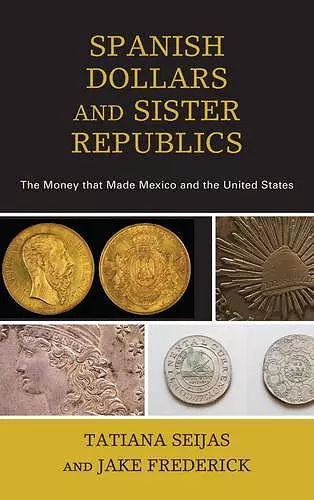Spanish Dollars and Sister Republics
The Money That Made Mexico and the United States
Tatiana Seijas author Jake Frederick author
Format:Hardback
Publisher:Bloomsbury Publishing PLC
Published:10th Feb '17
Currently unavailable, and unfortunately no date known when it will be back

Spanish Dollars and Sister Republics traces the linked history of the new nations of Mexico and the United States from the 1770s to the 1860s. Tatiana Seijas and Jake Frederick highlight the common challenges facing both countries in their early decades of independence by exploring the creation of coin money. The remarkable story begins when both countries chose the Spanish piece of eight (silver coin) as their monetary standard. The authors examine how each nation instituted its own currency, designed coins to represent its national ideals, and then spent decades trying to establish the legitimacy of its money. Readers learn about the creation and circulation of money through the stories of a banker in Philadelphia, a Mexican general in Texas, a surveyor in Sonora, and others. The focus on individuals provides an engaging window into the economic history of Mexico and the United States. Seijas and Frederick show how the creation of U.S. dollars and Mexican pesos paralleled these countries’ efforts to establish enduring political and economic systems, illustrating why these nations closed the nineteenth century on very different historical trajectories.
This is an original work that does a good job of connecting complex monetary and banking processes with the crucial political events of the period. * American Historical Review *
The authors contend that Spanish pieces of eight were the first global currency in 1535 and that Spanish silver coinage minted in the New World became the model for currency in the emerging republics of Mexico and the US. A single piece of eight was worth eight Spanish reales and required a standard silver content, coinage mints, banks, and treasury departments to flourish. Merchants in both South America and North America valued these coins (called ‘Spanish milled dollars’ in the British colonies) above all other currencies. Hard currency from anywhere was scarce in Colonial America, both South and North; merchants relied on credit, local tokens, and barter to conduct business. Mexico and the US had similar currency problems in the Colonial era after they each achieved independence. Eight profiles of key individuals illustrate the establishment of currency stability in both countries: Congressman John Page, merchant Stephen Girard, José Esteva (Mexican treasurer), President Sam Houston (Texas ), President López de Santa Anna (Mexico), boundary commissioner John Bartlett, Robert Patterson (director, US Mint), and Emperor Maximilian (Mexico). Concise and pithy, this engaging volume is recommended for students of economic and financial history.
Summing Up: Recommended. Upper-division undergraduates and above.
The monetary histories of the United States and Mexico have been entwined from the start. By highlighting key personalities and simplifying the complex global history of hard cash, Seijas and Frederick demonstrate why ready money mattered so much for these fledgling, ex-colonial nations even as their paths diverged. Many readers will be surprised to discover who depended on whom for silver currency, and for how long. Spanish Dollars and Sister Republics is transnational history at its best. -- Kris Lane, Tulane University
Seijas and Frederick have written an important book about a largely ignored subject that’s nevertheless fundamental to US, Mexican, and borderlands histories: money. The currencies of both countries had their roots in Spanish tradition, and when it came to creating symbols representative of freedom, finding enough specie for coins, or negotiating the terms of credit and debt, the early United States and Mexico faced financial challenges that were more similar than different. Their focus on shared histories is refreshing given today’s rhetoric of difference and division. -- Geraldo Cadava, Northwestern University
ISBN: 9781442265202
Dimensions: 238mm x 159mm x 17mm
Weight: 440g
196 pages